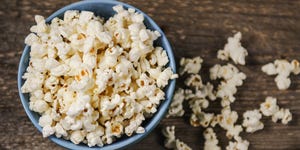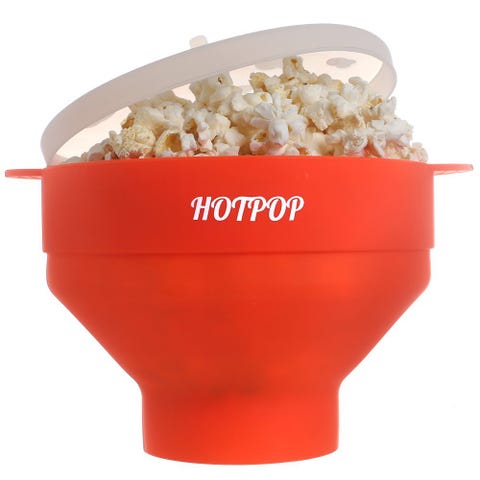

If you’re anything like me, you could probably down an entire large bag of popcorn during one 30-minute episode of Friends. You could probably even finish it in half the time if it’s slathered in cheddar cheesy goodness.
But, of course, that begs the question:
Is popcorn healthy?
Plain and simple, popcorn is a whole grain, just popped. “So while some people might look at it as a junk food, it’s not,” says Abby Langer, R.D., owner of Abby Langer Nutrition in Toronto, Canada. “It not only has a lot of fiber, but when it’s popped with very little fat, it’s quite low-calorie, as well. It also has a lot of volume, so it can make and keep you full. And it’s satisfying, thanks to its crunch.”

But, Langer says, sometimes it’s just a vehicle for other flavors and that’s where the good-for-you crunch can go bad. “The problem is that people just tend to overeat it,” she says, noting that a serving is typically one cup. “And when you overeat Smartfood or kettlecorn, you’re probably taking in more calories than expected.”
Popcorn nutrition facts
Ah, the stats that tell all. First things first, a plain ‘ol bag of popcorn won’t pop your calorie quota—or any other nutritional quota for that matter.
Here’s what you’ll get in one cup of plain, air-popped popcorn, per the USDA:
So even if you down three cups (so easy and pretty typical of me, tbh!), it’s less than 100 calories—without going overboard on carbs, sodium, or fat.
Of course, these numbers quickly change once you add in butter, cheese, caramel, or any other popular popcorn topping. We crunched the numbers (get it?):
Per 1-cup serving…
Plain
Buttered
White Cheddar (Smartfood)
Caramel
Kettlecorn (BJ’s)
Calories
31
64
91
172
93
Fat
0.4 g
5 g
6 g
5 g
5 g
Protein
1 g
0.8 g
2 g
1 g
1 g
Carbs
6 g
5 g
8 g
32 g
12 g
Fiber
1 g
0.9 g
1 g
2 g
1 g
Sodium
1 mg
100 mg
166 mg
82 mg
87 mg
Sugar
.07 g
.05 g
1 g
21 g
5 g
So even though the differences seem minimal, those numbers can def add up if you’re not sticking to a single-cup serving size. Three cups of buttered popcorn, for example, will net you 192 calories (twice that of plain popcorn) and 15 grams of fat (five times as much as the plain stuff).
“If you’re not going to limit yourself to a serving, then you really have to pay attention to the label and think about what you’re going to realistically consume,” Langer says.
What about those microwave bags?
It’s probably best to skip them, Langer says. Some brands have lots of trans fats or high amounts of saturated fat (beware that butter!). And she adds that there’s always the risk of getting “popcorn lung”—a type of lung disease associated with diacetyl (a chemical used in artificial butter flavoring on popcorn). But this last thing, tbh, is really only a risk if you’re constantly inhaling the fumes from your bag of freshly-popped popcorn. (So…don’t do that).

Original HotPop
If you want to play it safe, Langer suggests just throwing some kernels in a brown paper bag and popping them yourself in the microwave. You could also use an air popper, like this one from Amazon that’s BPA-free, dishwasher-safe, and only $12.
Another option if you’re willing to get your hands dirty: Cook it on the stovetop. Using a little coconut or olive oil, heat the oil in a deep pan, and add three kernels. When all three pop, add the rest and shake periodically. Then, you can add just a hint of parmesan cheese, salt and vinegar, a little hot sauce, or some of your favorite dried herbs and spices. The oil will add some extra calories and fat compared to just a plain, air-popped cup, but this method is still healthy (and delicious).
The bottom line: Popcorn is a pretty damn healthy snack, as long as you’re keeping it plain or adding just a hint of flavor. But don’t go all-in on that full bag of movie theater popcorn.
Source: Read Full Article